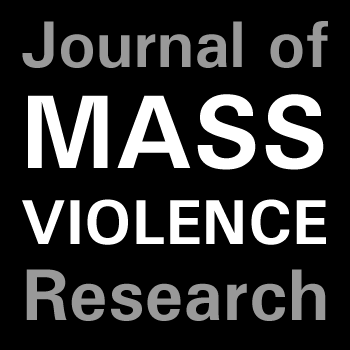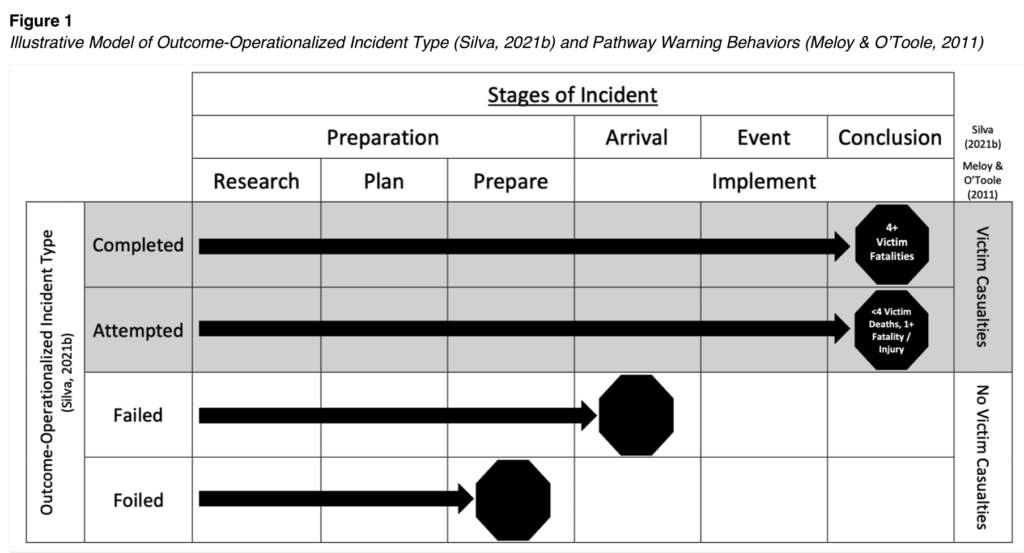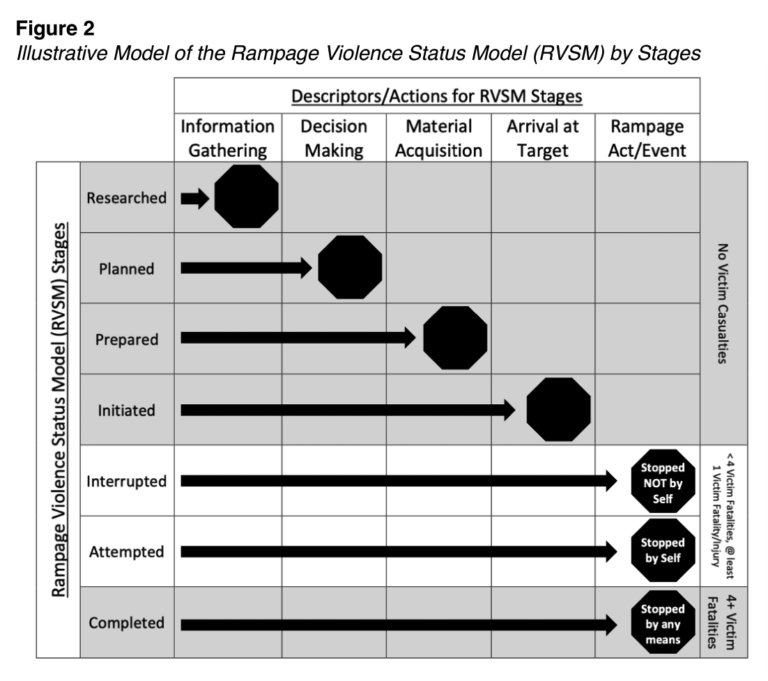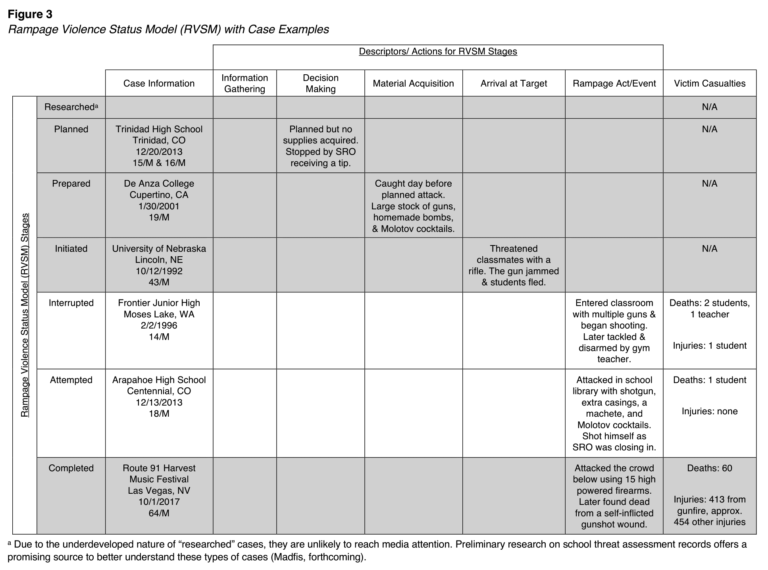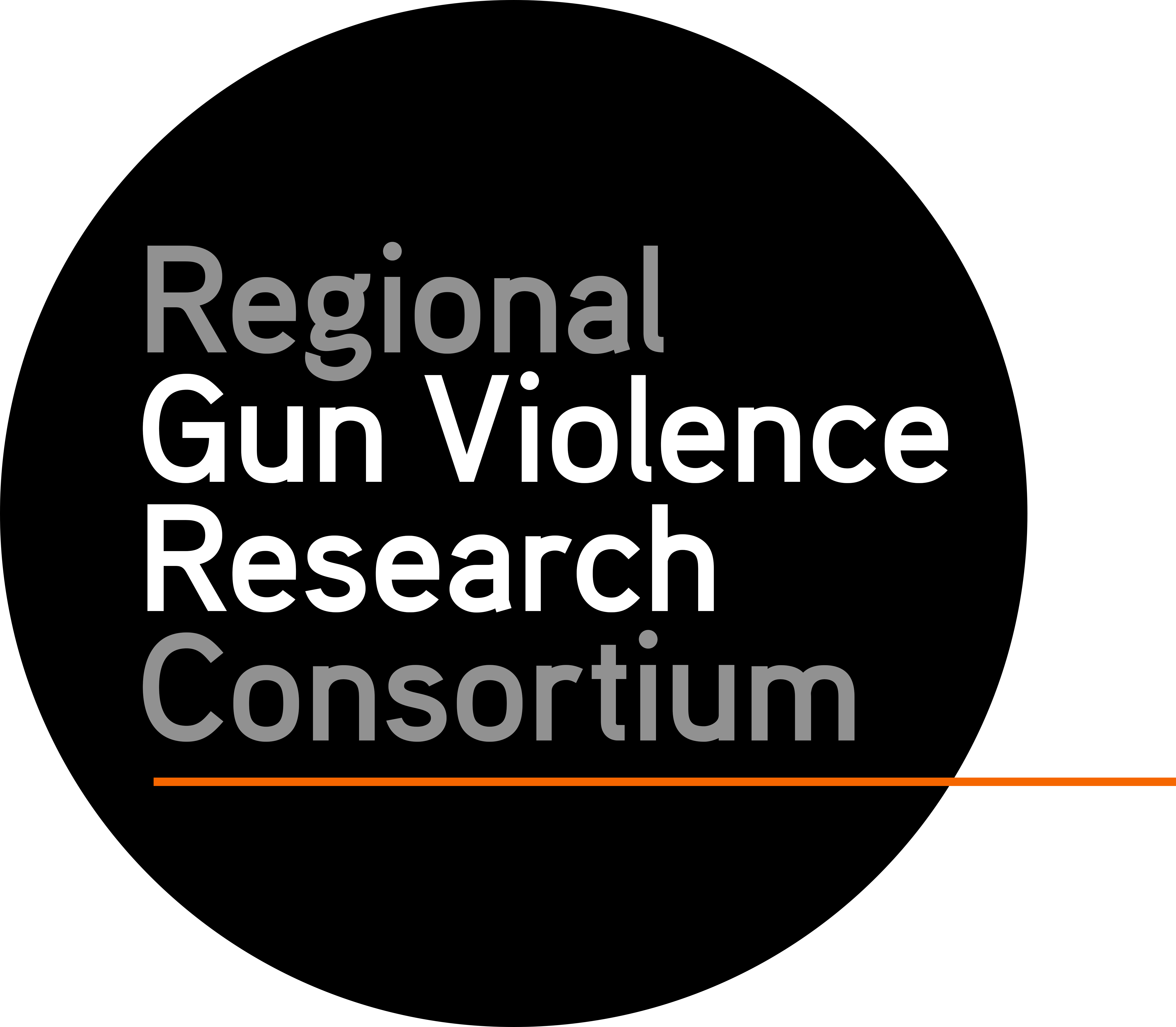SHARE THIS ARTICLE
Defining Rampage Violence Across Completion Status: Towards a More Comprehensive Model
School of Social Work and Criminal Justice, University of Washington Tacoma
Article History: Received July 28, 2022 | Accepted August 24, 2022 | Published Online September 12, 2022
ABSTRACT
The definitions and terms used to describe single-incident mass casualty events vary widely and remain contested. To allow for the inclusion of more incidents, larger and more representative samples, and more comprehensive analyses, we argue in favor of using the broad term “rampage” and propose a new model, the Rampage Violence Status Model (RVSM), which provides additional context on completion status and can subsume previous terminology. Additionally, by expanding upon previous researchers’ distinctions and definitions of various stages and completion statuses, we suggest adopting the following terms as stages in the progression of rampage violence, per the RVSM: researched, planned, prepared, initiated, interrupted, attempted, and completed.
KEYWORDS
mass shooting, rampage, rampage violence, averted, completion status, school shooting
Rampage violence has become a social problem of increasing concern in the 21st century, especially in the United States where more public mass shootings occur than anywhere else on the planet (Lankford, 2016, 2019; Lemieux, 2014; Madfis & Lankford, 2022; Silva, 2022). Further, public mass shootings have become more frequent (Peterson & Densley, 2020) and more deadly (Lankford & Silver, 2020) since the turn of the 21st century, and both public and private mass shootings have increased over the last few years during the COVID-19 pandemic (Schildkraut & Turanovic, 2022). As the problem has worsened and gained more public awareness over the last 20 years, the research on mass/rampage violence – public mass shootings, in particular – has also increased exponentially during this time (Duwe et al., 2021).
Traditionally, mass shootings have been defined as the killing of four or more people with firearms during a single episode at one or more closely related locations (Fox et al., 2018). However, this definition remains contested (Huff-Corzine & Corzine, 2020), and numerous similar terms can be found throughout the literature, such as mass murder (Duwe, 2007; Holmes & Holmes, 2001; Levin & Fox, 1985; Meloy & O’Toole, 2011), active shooting (Kissner, 2016; Rusho et al., 2021), mass violence (Daly, 2018; Huff-Corzine & Corzine, 2020), rampage (Madfis, 2014, 2020; Newman et al., 2004), and massacre (Harrison & Bowers, 2010; Schildkraut & Muschert, 2014). There are many more location-specific terms such as mass public shooting (Silva & Green-Colozzi, 2022), workplace massacre (Duwe, 2007), familicide (Liem at al., 2013), and mass school shooting (Curran et al., 2020; Paez et al., 2021). When considering terminology regarding how far into the act of mass violence the perpetrator was when it ceased, the list of terms grows further. Scholars have written about averted school rampage (Madfis, 2020), averted school violence (Cowan et al., 2022), averted school shooting (Daniels & Page, 2013), averted mass violence (Cowan et al., 2022), thwarted mass homicide (Sarteschi, 2016), and mass shooting with the designations of completed, attempted, failed, and foiled (Silva, 2021a, 2021b; Silva & Green-Colozzi, 2022), and school shootings as either completed or averted (Winch, 2021).
While some of the variations in terminology may be substantive (and entail important differences in offender profiles, attack behaviors, motivations, opportunities for intervention and prevention, etc.), far more research is needed to compare across these categories (Madfis, 2020). That said, we do know that many common factors and patterns among perpetrators exist (such as cumulative strains, extensive fantasizing about and planning for the rampage attack, desire for lasting fame, leakage of information about the threat to others, etc.; see Lankford et al., 2019; Levin & Madfis, 2009; Madfis, 2017) and persist despite, for example, variations in the site of the mass violence (see, for example, Silver et al., 2018).
As empirical knowledge of mass violence expands it would be helpful to utilize universal language to explore this violent phenomenon with a more standardized set of terminology. The increasing frequency of mass violence in the United States and its damaging effects on society suggest the dire need for empirical research which is more easily understandable and less contradictory in the use of language so that research may better inform public debate and policy. Scholars’ use of more universal and uniform language is one method to potentially address this need. Though some scholars (such as Huff-Corzine & Corzine, 2020) discourage the implementation of any standardized definitions around the phenomenon due to the desire to keep various forms of mass violence distinct from one another, we contend that more universal language and terminology for these acts can benefit this area of study if developed in a systematic way with holistic intent.
In this article, we summarize how previous studies have defined and operationalized mass violence (and associated terms such as mass shootings, rampage, mass murder, etc.) across the spectrum of attempts and completed acts and argue in favor of adopting terminology which is as broad as possible, yet retains the most crucial identifying features so as to maintain distinctions between single-incident mass casualty events and other multiple-incident mass casualty events like serial killings and state-sponsored mass violence such as genocides. To that end, we suggest adopting the broad term rampage to which specificity can be added. For example, the location and weapon of rampage violence may be further specified by referring to a school rampage stabbing or a workplace rampage shooting. Further, the completion status of an attack may be characterized as a completed, attempted, interrupted, arrived, prepared, planned, or researched rampage to clarify how far along the offender was able to carry out their deadly plot (these new terms will be defined and explained later in this piece). Thus, instances could be referred to as, for example, a completed school rampage stabbing or an attempted workplace rampage shooting.
Prior Debates Over Terminology
In scholarship on homicide, the first term used to refer to single-incident mass casualty events was “mass murder” (Fox & Levin, 1998), and the traditional definition limits the phenomenon to those events wherein at least four victims were killed during a single episode at one or more closely related locations (Duwe, 2007; Fox et al., 2018; Holmes & Holmes, 2001). The term mass murder is deliberately broad so as to encompass all types of weapons used, including knives, axes, guns, bombs, and any other potentially deadly weapon. In recent years, terms such as “mass shooting” and “active shooting” have become far more prevalent (Fox & Levin, 2015). The aforementioned terms focus only on gun violence, and many studies specifically limit their qualifying criteria to only include incidents of mass violence in which firearms were the primary weapon (see Newman et al., 2004 for an example). As Madfis (2020) notes, however, in his study of averted incidents of school rampage plots, numerous deadly school violence plans were formed by students which involved knife attacks and the use of various types of bombs, explosives, and incendiary weapons. Likewise, bombs were a vital component of the Columbine High School killer duo’s plan though most were not detonated (Larkin, 2007). Further, the deadliest mass murder at a school in American history (the 1927 Bath School Disaster in Michigan) involved dynamite and hundreds of pounds of pyrotol, but no firearms (Bernstein, 2009), and the deadliest mass casualty event committed by a single perpetrator (the 2011 Norway attacks) utilized both bombs and guns. Amman and colleagues (2022) recently found 138 mass stabbing attacks across the world between 2004 and 2017.
Accordingly, we suggest using the term rampage in line with Madfis (2020) so that all types of weaponry may be included in future operationalizations and subsequent datasets. Certainly, guns enable far more deaths in a shorter timespan than less lethal weapons like knives and axes (Madfis & Levin, 2013), but, until such time as there is evidence to suggest that substantial differences exist in terms of motivation or other characteristics between those who utilize guns and those who utilize other weapons to commit their attacks, the broader term rampage should be adopted to allow for the inclusion of more incidents, larger samples that are more representative, and thus more comprehensive analyses.
Other important definitional debates in the mass violence literature have included excluding cases based on the location of the attack (e.g., removing cases of familicides in private homes), offender’s connection to the attack site (e.g., limiting cases to school attacks only by former and current students), the relationship between offenders and victims (as specific or random targets), and by the number of victims killed or injured (Daniels et al., 2007, 2010; Levin & Madfis, 2009; Moore et al., 2003; Muschert, 2007; Newman & Fox, 2009; Newman et al., 2004; Vossekuil et al., 2002). We view all of these exclusion criteria as problematic (and as having the potential to create less representative samples), unless done for specific methodological, conceptual, or pragmatic reasons.
In particular, we take issue with the practice of requiring specific death counts as an inclusion criterion. Such a focused definition needlessly omits myriad cases which have not resulted in multiple deaths (Madfis, 2020). Cases in which the perpetrator has the desire and intent to kill multiple victims yet fails to do so when their plans come to the attention of authorities before being effectuated and those who severely injure many people but fail to do so fatally are excluded in conventional definitions of mass murders and mass shootings. As Madfis (2020) states, “These less-successful perpetrators may be distinguishable by their overall incompetence with weaponry and/or their inability to maintain secrecy about their future actions, but not necessarily by their original motivations and goals” (p. 169). Therefore, there is much use in adopting the broader notion of rampage violence and including all cases which involve an attempt to kill multiple people in a single event (White-Hamon, 2000; Madfis, 2020).
One of the newest and most interesting areas of emergent scholarship in this area is the issue of completion status, or how far along the perpetrator was able to carry out their deadly plot to kill multiple victims. The first studies to explore cases of averted incidents (such as Daniels & Page, 2013; Daniels et al., 2007, 2010; Larkin, 2009; Madfis, 2014) exclusively did so in the context of school settings, but knowledge and terminology in this area has rapidly expanded in recent years.
As Daniels and Page (2013) identify, studying something that may or may not have eventually happened but was stopped is complicated. To combat this, they took an approach inspired by the study of law, selecting only cases which had sufficient evidence to bring about conviction for an imminent shooting (Daniels & Page, 2013). Winch (2021) considered a case averted if there was any evidence that the perpetrator demonstrated pathway engagement (Calhoun & Weston, 2003), such as researching past school shootings, planning for an attack in various ways, or preparing for the attack by acquiring a gun. Other definitions and use of terminology regarding completion status also consider activity engagement and process. Meloy and O’Toole (2011) explore leakage, which is a type of pathway warning behavior wherein there is “communication to a third party of an intent to do harm to a target” (p. 513). These researchers found pathway warning behaviors to be a predominant theme in several types of violent crime, including mass murder and school shootings. According to Meloy and O’Toole (2011) pathway warning behaviors are any that contribute to the steps of researching (learning and gathering useful information from past attacks), planning (selection of the time, location, method of attack, and entry method), preparing for (weapons and materials acquisition), and implementation of a violent incident, and that with each step the risk of violence and harm to others increases. Incorporated into Winch’s (2021) conceptualization, each of these pathway warning behaviors up to implementation meets the criteria for an averted school shooting. Once a perpetrator reaches the implementation stage, the case was deemed a completed school shooting if there was at least one injury and the incident occurred on school grounds during school hours or at a school event after hours.
Silva (2021a, 2021b) introduced a series of terms defining the progress of a mass shooting incident based on outcome operationalization. This work defined a mass shooting as a gun incident committed by 1+ person in 1+ public or populated setting within a 24-hour period in which at least some intended victims were selected randomly and/or for symbolic value. This model expands on previously used completion status concepts, offering four casualty- and target-based outcome categories and terms from least to most severe: foiled, failed, attempted, and completed (Silva, 2021a, 2021b). Offering further clarification on stages of completion status, Silva and Green-Colozzi (2022) identify four stages of a mass shooting as preparation, arrival, event, and conclusion.
A foiled mass shooting is an incident which the perpetrator has set into motion but was stopped before the incident began, such as never reaching their intended target (Silva, 2021a, 2021b). This definition is rooted in Sarteschi’s (2016) concept of high credibility cases, in which an offender has explicitly stated their intention to carry out a mass shooting attack, identified a target or type of target, and already has a gun, has attempted to acquire one, or has a plan to do so. An incident is considered a failed mass shooting if the plan was set into motion but stopped during the incident (Silva, 2021b). For example, in a failed mass shooting case, the perpetrator would have finished preparations, arrived at the intended target, and perhaps began shooting but is then interrupted (e.g., killed or tackled) (Capellan & Gomez, 2018; Silva & Green-Colozzi, 2022). Both foiled and failed mass shootings have no casualties (Silva, 2021b).
Conversely, attempted and completed mass shooting incidents both include casualties. The distinction between these two categories rests on the number and type of casualties associated. In an attempted mass shooting, the plan has been effectuated and ended with less than four deaths but at least one victim casualty (injury or fatality). A completed mass shooting is characterized by four or more fatalities, not including the perpetrator (Silva, 2021a, 2021b).
Silva’s (2021a, 2021b) outcome operationalization model and Meloy and O’Toole’s (2011) stages based on pathway warning behavior overlap, each adding specificity to different phases of an incident. We submit that, taken together, these approaches can offer unifying terminology and definitions that can be applied to all incidents of rampage violence, no matter the location or weaponry, and such an approach provides the most comprehensive way to provide information and analysis on the completion status of incidents. At present, Silva (2021b) created the stages of preparation, arrival, event, and conclusion, while Meloy and O’Toole (2011) specify research, planning, preparation, and implementation stages. As illustrated in Figure 1, the definitions of these stages overlap, allowing Meloy and O’Toole’s research, plan, and prepare stages to add a deeper level of detail to Silva’s preparation stage. Further, Silva’s arrival, event, and conclusion stages increase the detail and nuance of Meloy and O’Toole’s (2011) implementation stage.
Rampage Violence Status Model
Taken together, previous scholarship has offered numerous varied conceptualizations, operationalizations, and terminology options to discuss mass and rampage violence incidents. However, some terms and definitions are needlessly limiting, several prior conceptualizations overlap, and some terms are synonymous and virtually indistinguishable from one another. Previous models and concepts have moved the field forward and provided much needed insight and clarity. However, we propose a new model, the Rampage Violence Status Model (RVSM) (see Figure 2), which is meant to be more comprehensive, cohesive, and inclusive as it provides additional context on completion status and can subsume previous terminology (see Figure 3 for examples of cases that represent each stage of the RVSM). Additionally, this model provides terms that move the field forward by allowing the examination of perpetrators’ intentions.
Building and expanding on previous researchers’ (such as Meloy & O’Toole, 2011; Silva 2021a, 2021b) distinctions and definitions of various stages and completion statuses, we suggest adopting the following terms as stages in the progression of rampage violence, per the RVSM: researched, planned, prepared, initiated, interrupted, attempted, and completed.
Researched rampage violence is an incident in which the perpetrator(s) has/have researched and gathered information from previous attacks for their own use before their efforts were stopped. At this early stage, any incident would be very undeveloped.
Planned rampage violence occurs when the perpetrator(s) has/have completed the research stage and moved on to planning their own attack. This could include decisions being made as to the time and location of their act, identifying and/or listing targets, selecting a method of attack or weaponry, creating plans to acquire those weapons, choosing entry points, acquiring or sketching blueprints/layouts of their selected location, etc. A rampage violence act is described as planned if any of these decisions have been made when the plot is discovered and stopped.
Prepared rampage violence is a plot which has passed the research and planning stages and the perpetrator(s) has/have now either acquired or attempted to acquire weapons and materials needed for the event when stopped. This definition also includes any efforts to create, pack, or transport the materials and weapons required for the plot.
An incident would be considered initiated rampage violence if the perpetrator(s) has/have surpassed the three previous stages and successfully arrived at their targeted location to carry out their plot. However, the
act is stopped before any injuries or fatalities have occurred at the target location. These four terms –researched, planned, prepared, and initiated rampage violence – refer to acts that could have been stopped by the perpetrator(s) via personal failure or leakage behaviors, by family, friends, or various community members, or by intervention from law enforcement. Additionally, these terms define completion stages of a rampage violence act in which there are no victim injuries or fatalities.
In contrast, interrupted rampage violence is an act in which the perpetrator(s) has/have successfully passed all previous stages and initiated their plot but was/were stopped or interrupted by anyone other than the perpetrator(s). An interrupted rampage violence event results in less than four victim fatalities but has at least one victim injury or fatality. Similarly, attempted rampage violence reaches the same stage of completion and victim outcomes as interrupted rampage violence, however, it is notably distinct in that this act concludes due to action(s) taken by the perpetrator(s). In other words, an attemptted rampage violence event stops by the perpetrator’s own hand, for example by suicide or surrender.
The interrupted and attempted rampage violence classifications provide terminology to explore perpetrators’ plans versus what occurred, by distinguishing between an act being stopped by others rather than a perpetrator choosing its completion. If a perpetrator is stopped by law enforcement, the ending was defined by law enforcement. The intended plot could have included more targets, additional types of weapons, and so on. However, if a perpetrator chooses when the event is finished, one can presume the perpetrator accomplished their intended plan or revised their plan during the event and reached a point of satisfaction or resolution.
Finally, completed rampage violence represents an event which passes all stages and meets the commonly accepted “mass” threshold of four or more victim fatalities. In this model, a completed rampage violence act can be stopped either by the perpetrator or any other means.
Conclusion
Rampage violence is an increasingly common and deadly social phenomenon, and the continued empirical work in this area is vital for future preventative efforts. Prior conceptualizations and operationalizations are inconsistent across studies, and this can create confusion within the body of empirical research and among the public more generally.
The RVSM provides more standardized language and terminology around these devastating events, and its widespread adoption could serve to advance the discussion in meaningful, tangible ways. Adoption of the RVSM provides distinct, clearer terms which subsume previous terminology and clarify context about completion status and information on the number of victim casualties. In addition, the model furthers this area of study by capturing more events, therefore increasing sample sizes so that they are more representative and inclusive of various forms of single-incident mass casualty events. The unifying language of the RVSM allows scholars to adopt more standardized language and thus increase accessibility and comprehension for both scholars and relevant stakeholders outside of academia.
DISCLOSURE STATEMENT
No potential conflicts of interest were reported by the authors.
REFERENCES
Amman, M., Burnette, A., & Crowley, B. (2022). A review of mass stabbing attacks between 2004 and 2017. Journal of Threat Assessment and Management, 9(2), 111-128. https://doi.org/10.1037/tam0000177
Bernstein, A. (2009). Bath massacre: America’s first school bombing. Ann Arbor, MI: University of Michigan Press. https://doi.org/10.3998/mpub.283846
Calhoun, F. S., & Weston, S. (2003). Contemporary threat management: A practical guide for identifying, assessing, and managing individuals of violent intent. Specialized Training Services.
Capellan, J. A., & Gomez, S. (2018). Change and stability in offender, behaviours, and incident-level characteristics of mass public shootings in the United States, 1984–2015. Journal of Investigative Psychology and Offender Profiling, 15(1), 51-72. https://doi.org/10.1002/jip.1491
Cowan, R. G., Tedeschi, P. J., Corbin, M., & Cole, R. (2022). A mixed-methods analysis of averted mass violence in schools: Implications for professional school counselors. Psychology in the Schools, 59(4), 817-831. https://doi.org/10.1002/pits.22647
Curran, F. C., Fisher, B. W., & Viano, S. L. (2020). Mass school shootings and the short-run impacts on use of school security measures and practices: National evidence from the Columbine tragedy. Journal of School Violence, 19(1), 6-19. https://doi.org/10.1080/15388220.2019.1703713
Daly, S. E. (2018). Assessing and averting the prevalence of mass violence. Hershey, PA: IGI Global.
Daniels, J. A., & Page, J. W. (2013). Averted school shootings. In N. Böckler, W. Heitmeyer, P. Sitzer, & T. Seeger (Eds). School shootings: International research, case studies, and concepts for prevention (pp. 421-439). New York, NY: Springer. https://doi.org/10.1007/978-1-4614-5526-4_19
Daniels, J. A., Buck, I., Croxall, S., Gruber, J., Kime, P., & Govert, H. (2007). A content analysis of news reports of averted school rampages. Journal of School Violence, 6(1), 83-99. https://doi.org/10.1300/J202v06n01_06
Daniels, J. A., Volungis, A., Pshenishny, E., Gandhi, P., Winkler, A., Cramer, D., & Bradley, M. C. (2010). A qualitative investigation of averted school shooting rampages. The Counseling Psychologist, 38(1), 69-95. https://doi.org/10.1177/0011000009344774
Duwe, G. (2007). Mass murder in the United States: A history. Jefferson, NC: McFarland & Company.
Duwe, G., Sanders, N., Rocque, M., & Fox, J. A. (2021, November 30). Estimating the global prevalence of mass public shootings [presentation]. https://nij.ojp.gov/media/video/27696
Fox, J. A., & Levin, J. (1998). Multiple homicide: Patterns of serial and mass murder. Crime and Justice, 23, 407-455. https://doi.org/10.1086/449274
Fox, J. A., & Levin, J. (2015). Mass confusion concerning mass murder. The Criminologist, 40(1), 8-11.
Fox, J. A., Levin, J., & Fridel, E. E. (2018). Extreme killing: Understanding serial and mass murder. Thousand Oaks, CA: Sage.
Harrison, M. A., & Bowers, T. (2010). Autogenic massacre as a maladaptive response to status threat. Journal of Forensic Psychiatry & Psychology, 21(6), 916-932. https://doi.org/10.1080/14789949.2010.506618
Holmes, R. M., & Holmes, S. T. (2001). Mass murder in the United States. Upper Saddle River, NJ: Prentice Hall.
Huff‐Corzine, L., & Corzine, J. (2020). The devil’s in the details: Measuring mass violence. Criminology & Public Policy, 19(1), 317-333. https://doi.org/10.1111/1745-9133.12482
Kissner, J. (2016). Are active shootings temporally contagious? An empirical assessment. Journal of Police and Criminal Psychology, 31, 48-58. https://doi.org/10.1007/s11896-015-9163-8
Lankford, A. (2016). Public mass shooters and firearms: A cross-national study of 171 countries. Violence and Victims, 31(2), 187-199. https://doi.org/10.1891/0886-6708.VV-D-15-00093
Lankford, A. (2019). Confirmation that the United States has six times its global share of public mass shooters, courtesy of Lott and Moody’s data. Econ Journal Watch, 16(1), 69-83. https://econjwatch.org/File+download/1105/LankfordMar2019.pdf?mimetype=pdf
Lankford, A., Adkins, K. G., & Madfis, E. (2019). Are the deadliest mass shootings preventable? An assessment of leakage, information reported to law enforcement, and firearms acquisition prior to attacks in the United States. Journal of Contemporary Criminal Justice, 35 (3), 315-341. https://doi.org/10.1177/1043986219840231
Lankford, A., & Silver, J. (2020). Why have public mass shootings become more deadly? Assessing how perpetrators’ motives and methods have changed over time. Criminology & Public Policy, 19(1), 37-60. https://doi.org/10.1111/1745-9133.12472
Larkin, R. W. (2007). Comprehending Columbine. Philadelphia, PA: Temple University Press.
Larkin, R. W. (2009). The Columbine legacy: Rampage shootings as political acts. American Behavioral Scientist, 52(9), 1309-1326. https://doi.org/10.1177/0002764209332548
Lemieux, F. (2014). Effect of gun culture and firearm laws on gun violence and mass shootings in the United States: A multi-level quantitative analysis. International Journal of Criminal Justice Sciences, 9, 74-93.
Levin, J., & Fox, J. A. (1985). Mass Murder: America’s Growing Menace. New York, NY: Plenum Press.
Levin, J., & Madfis, E. (2009). Mass murder at school and cumulative strain: A sequential model. American Behavioral Scientist, 52(9), 1227-1245. https://doi.org/10.1177/0002764209332543
Liem, M., Levin, J., Holland, C. & Fox, J. A. (2013). The nature and prevalence of familicide in the United States, 2000–2009. Journal of Family Violence, 28, 351-358. https://doi.org/10.1007/s10896-013-9504-2
Madfis, E. (2014). Averting school rampage: Student intervention amid a persistent code of silence. Youth Violence and Juvenile Justice, 12(3), 229-249. https://doi.org/10.1177/1541204013497768
Madfis, E. (2017). In search of meaning: Are school rampage shootings random and senseless violence? The Journal of Psychology: Interdisciplinary and Applied, 151(1), 21-35. https://doi.org/10.1080/00223980.2016.1196161
Madfis, E. (2020). How to stop school rampage killing: Lessons from averted mass shootings and bombings. New York, NY: Palgrave Macmillan.
Madfis, E. (Forthcoming). School threat assessment in the pacific northwest: Challenges and opportunities. Data analysis in progress.
Madfis, E., & Lankford, A. (Eds.). (2022, In press). All-American massacre: The tragic role of American culture and society in mass shootings. Philadelphia, PA: Temple University Press.
Madfis, E., & Levin, J. (2013). School rampage in international perspective: The salience of cumulative strain theory. In N. Böckler, W. Heitmeyer, P. Sitzer, & T. Seeger (Eds). School shootings: International research, case studies, and concepts for prevention (pp. 79-104). New York, NY: Springer.
Meloy, J., & O’Toole, M. E. (2011). The concept of leakage in threat assessment. Behavioral Sciences and the Law, 29(4), 513-527. https://doi.org/10.1002/bsl.986
Moore, M. H., Petrie, C. V., Braga, A. A., & McLaughlin, B. L. (2003). Deadly lessons: Understanding lethal school violence. Washington, DC: National Academies Press.
Muschert, G. W. (2007). Research in school shootings. Sociology Compass, 1(1), 60-80. https://doi.org/10.1111/j.1751-9020.2007.00008.x
Newman, K. S., & Fox, C. (2009). Repeat tragedy: Rampage shootings in American high school and college settings, 2002–2008. American Behavioral Scientist, 52(9), 1286-1308. https://doi.org/10.1177/0002764209332546
Newman, K. S., Fox, C., Roth, W., Mehta, J., & Harding, D. (2004). Rampage: The social roots of school shooters. New York: Perseus Books.
Paez, G. R., Capellan, J. A., & Johnson, M. G. (2021). Contextualizing mass school shootings in the United States. Journal of Investigative Psychology and Offender Profiling, 18(3), 170-184. https://doi.org/10.1002/jip.1577
Peterson, J., & Densley, J. (2020). The Violence Project database of mass shootings in the United States, 1966–2020. https://www.theviolenceproject.org
Rusho, M. A., Ahmed, A., & Sadri, A. M. (2021). Social media response and crisis communications in active shootings during COVID-19 pandemic. Transportation Research Interdisciplinary Perspectives, 11, 100420. https://doi.org/10.1016/j.trip.2021.100420
Sarteschi, C. (2016). An examination of thwarted mass homicide plots and threateners. Aggression and Violent Behavior, 30, 88-93. https://doi.org/10.1016/j.avb.2016.06.010
Schildkraut, J., & Muschert, G. W. (2014). Media salience and the framing of mass murder in schools: A comparison of the columbine and sandy hook massacres. Homicide Studies, 18(1), 23-43. https://doi.org/10.1177/1088767913511458
Schildkraut, J., & Turanovic, J. J. (2022). A new wave of mass shootings? Exploring the potential impact of COVID-19. Homicide Studies, 26(4), 362-378. https://doi.org/10.1177/10887679221101605
Silva, J. R. (2021a). A comparative analysis of foiled and completed mass shootings. American Journal of Criminal Justice. https://doi.org/10.1007/s12103-020-09552-2
Silva, J. R. (2021b). Mass shooting outcomes: A comparison of completed, attempted, failed, and foiled incidents in America. Deviant Behavior. https://doi.org/10.1080/01639625.2021.1991248
Silva, J. R. (2022). Global mass shootings: Comparing the United States against developed and developing countries. International Journal of Comparative and Applied Criminal Justice. https://doi.org/10.1080/01924036.2022.2052126
Silva, J. R., & Greene-Colozzi, E. A. (2022). An exploratory study of failed mass shootings in America. Security Journal, 35(2), 367-399. https://doi.org/10.1057/s41284-020-00281-z
Silver, J., Horgan, J., & Gill, P. (2018). Shared struggles? Cumulative strain theory and public mass murderers from 1990 to 2014. Homicide Studies, 23(1), 64-84. https://doi.org/10.1177/1088767918802881
Vossekuil, B., Fein, R., Reddy, M., Borum, R., & Modzeleski, W. (2002). The final report and findings of the safe school initiative: Implications for the prevention of school attacks in the United States. Washington, DC: U.S. Secret Service and U.S. Department of Education. https://www.govinfo.gov/content/pkg/ERIC-ED466024/pdf/ERIC-ED466024.pdf
White-Hamon, L. S. (2000). Mass murder and attempted mass murder: An examination of the perpetrator with an empirical analysis of typologies. Unpublished doctoral dissertation, California School of Professional Psychology, Fresno, CA
Winch, A. (2021). An evaluation of the differences between perpetrators in completed and averted school shootings. Electronic Theses and Dissertations. 785. https://stars.library.ucf.edu/etd2020/785/
About the Authors
Janelle Hawes is an Assistant Professor in the School of Social Work and Criminal Justice at the University of Washington Tacoma. Her past research focused on youth experiences in the education, foster care, and juvenile legal systems. Currently she is conducting program assessments and other applied evaluations for police departments in the region, with specific attention paid to matters of diversity, inclusion, workplace climate, and community engagement of police officers.
Eric Madfis is an Associate Professor in the School of Social Work and Criminal Justice at the University of Washington Tacoma. His work has been published in academic journals across a range of disciplines and featured in national and international media outlets. He is the author of How to Stop School Rampage Killing: Lessons from Averted Mass Shootings and Bombings and co-editor of the forthcoming book All-American Massacre: The Tragic Role of American Culture and Society in Mass Shootings.
